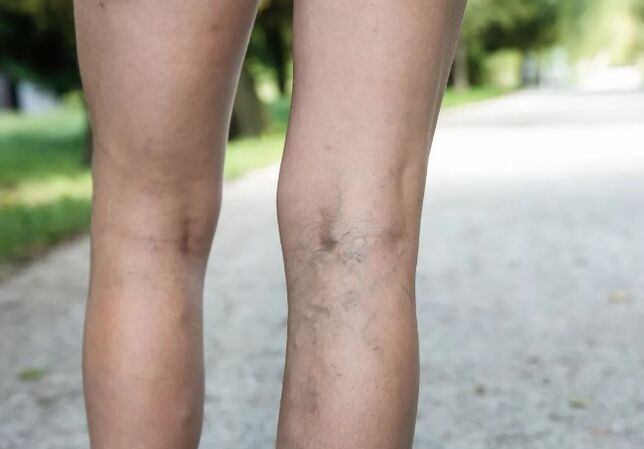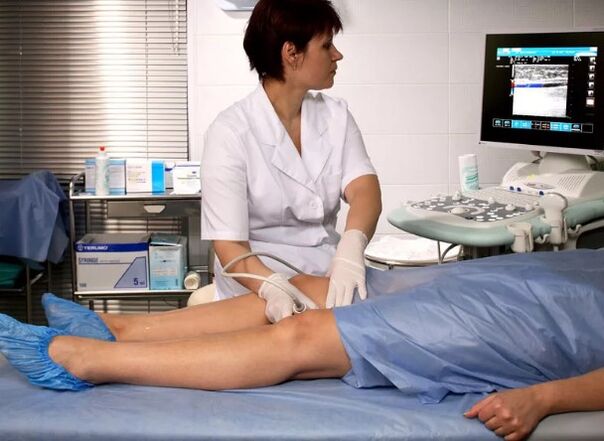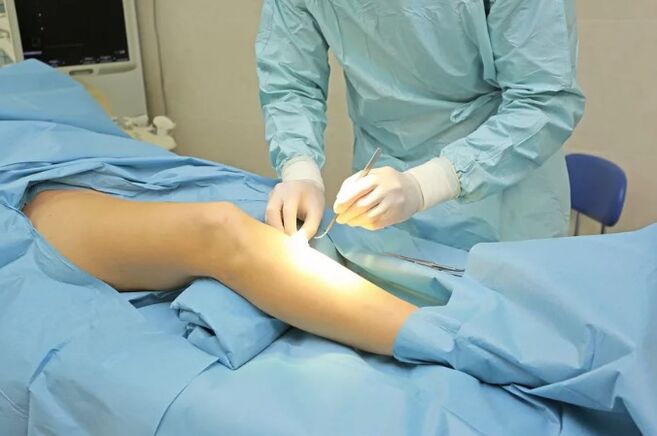Varicose veins in the feet are the specific expansion of the lower leg vein, which is accompanied by general infringement of blood flow and valve failure. The development of veins is a characteristic of women and men aged 40 to 60.

The mechanism of development
Triggers in the development of such pathology as varicose veins are considered to be a violation of the normal operation of the vein valve with blood reflux (reflux - inverted). At the cellular level, this is associated with a violation of the balance between several components of the vein wall.
The initial stage is characterized by the presence of genetic and causal factors (prolonged in sitting, overweight, injury, etc. ). At the same time, the change of shear parameters is called, which is a set of blood movement through vessels, in which the endothelium responds very sensively.
If the annoying factor acts for a long time on the vessel wall, then the leukocytes are firmly mounted to the endothelial cells, which causes the early stages of inflammation. The process of inflammation spreads through the lower leg vein.
Especially quickly, such a process occurs in the valve, which is subject to persistent and heavy mechanical stress. However, inflammation on one foot can be more noticeable than the other. First of all, it depends on the early causes of damage to the organ, for example, in the right leg, varicose veins can be more clear among the athletes who emphasize it.
With damage to the valve, the release of blood pathology occurs through the mouth of large and small subcutaneous veins. Due to reboots, excessive blood flow, the walls of the vessels occur.
Over time, dynamic venous hypertension develops, characterized by a decrease in pressure in the vessel, as a rule, this occurs during walking, to a stage of impairment ensuring normal blood perfusion through the tissue.
Such a process is accompanied by edema, impregnation of subcutaneous tissue with blood cells (red blood cells and leukocytes). Over time, the skin changes color, swollen, enhanced skin pigmentation. With cell death, which is indecent during medical treatment, which in turn leads to the development of trophic ulcer.

Classification of varicose veins
From 2000, the new classification of varicose veins at the lower leg has been developed.
Varicose veins:
- Intradermal varicose veins or segments without pathological changes;
- Segmental varicose veins with shallow vein reflux;
- Normal varicose veins of the surface veins;
- Varicose development with the presence of deep vein reflux.
Chronic vein deficiency level:
- 0 - does not grow;
- Me - "heavy leg" syndrome, edema appearance;
- II - persistent edema, eczema, lipodermosclerosis;
- III - trophic ulcer.
Complications of expansion of lower limbs veins are one of the serious conditions that affect the body: thrombophlebitis, trophic ulcer, erysipelas, erysipelas or bleeding.
Classification of the work of the disease
According to the form:
- Varicose veins subcutaneous veins (starting from the mouth) - decreased varicose veins;
- Varicose veins rise (wen loss, lower leg and feet, starting from the bottom up);
By clinical groups:
- The first group is the internal expansion of the vein segment without the perforator;
- The second group is the expansion of venous sticks;
- The third group is the development of subcutaneous veins of the thighs and lower legs;
- The fourth group is an extension of varicose veins from large and small subcutaneous veins in the presence of insolvent perforators;
- The fifth group is the development of surface veins, large subcutaneous veins with tissue induction.
The classification of work by complications and the level of chronic failure is not different from the standard.
Reason for the development of varicose veins
The right reasons for the development of this pathology have not been fully explained, but there are several factors that contribute to the occurrence of varicose veins:
- Genetic predisposition (mutation gene responsible for the structure of the vessel wall is transmitted);
- Changes in hormone background (pregnancy - during pregnancy, hormone composition in body changes (increased progesterone and estrogen decreases), which directly affects the formation of blood clotting factors);
- Obesity (overweight leads to an inactive lifestyle, and, consequently, to damage);
- Diabetes mellitus (increased blood sugar in time to damage the vessel wall over time);
- alcohol abuse (large amounts of alcohol in the blood are the cause of dehydration and blood condensation);
- heavy physical activity;
- congenital blood clotting disorders;
- irrational nutrition, error in diet;
- Uncomfortable and close underwear (continuous wear leads to blood vessels);
- frequent constipation (increased intra -abdomen pressure leads to difficult blood flow to the bottom);
- walking directly in the heel (the development of stagnation and inadequate muscle movement);
- increased air temperature (leading to dehydration, condensation of blood, and, consequently, to the formation of blood clots);
- diseases of the cardiovascular and kidney systems;
- excessively with drugs that increase blood clotting;
- Surgical intervention (blood loss, vessel compression).

Varicose vein stage
For this period of medical development, the three main stages of varicose veins and early stages are distinguished, when the disease is very difficult to observe.
The early stages of the disease are accompanied by swelling, weight loss, very often complaining that the feet are sore during walking. These are all signs of pathological beginning, it's time to start prevention - massage, foot cream, physical activity.
Development of veins in the first stage.This stage is characterized by all the symptoms listed above, where the stars of the vascular, bruising on the feet, the veins are tied, visible through the skin, added. In addition, the appearance of seizures at night and burning in the area stopped.
Development of veins to -2.At this stage, the number of stars and nodes increases, they become more prominent. Swelling appears, pain in the foot increases, and it becomes unbearable to hold it.
Development of the 3rd title vein.This is the hardest on the stage, accompanied by serious wounds from the skin, it becomes dry, lifeless and cracked. The lower bark becomes dark blue, its structure and pigmentation change.
The third stage is the last when this pathological process can be called varicose veins. The development of the next process stops with a more serious disease.
It is advisable to consult a doctor in the second stage of the development of the disease, since the time, medical care has not been given serious consequences.
The question arises, "Which doctor will he go? ", The answer is simply - a doctor who specializes in the pathology of the lower veins is called a phlebologist.

Symptoms and veins of the clinic varicose
The main signs of the disease are many subcutaneous vein connections, which is why the disease is called. The onset of the disease is usually accompanied by some and non -specific features.
In the state, patients feel severe in the legs, rapid fatigue during movement, sometimes burning and cramps. In addition to pain, the disease is characterized by edema that develops in the evening, after a hard work day.
With long varicose veins, symptoms such as eczema and itching appear. Patients scratch their feet, making uncomfortable sensations. Due to the development of the disease, the skin on the veins becomes thinner, the place of itching is always brushed, leading to the appearance of wounds.
Over time, the color of the skin in the lower leg is bluish. If medical treatment is not provided in such cases, the development of skin hyperpigmentation and lipodermasclerosis is possible. In advanced stages, trophic ulcers develop.
Diagnosis of a disease
Expanded Veins with a variety of visible and unarmed with armed appearance, however, how dangerous this condition should be found using instrumental diagnostic methods.
Currently, the most informative method is the ultrasound methodology of the vein duplex scanner. With its help, it is evaluated by valve operation, cross capacity and presence of blood clot. Timely studies will avoid severe and irreversible consequences.
Method of treatment
How to treat varicose veins? Actually cure varicose veins is only possible with the help of surgical intervention. People with hereditary tendencies or risk factors recommend visiting a specialist doctor 2-3 times a year, for ultrasound examination of veins, surgery from varicose veins is prescribed in the second stage of disease progression.
What is the cost of operations? Prices can be done differently, depending on the severity of the disease.

Surgical
Flebectomy
Signs for removal of veins: extensive varicose veins, development of subcutaneous vein pathology, trophic ulcer, acute thrombophlebitis, deep vein development accompanied by general fatigue (fatigue, dizziness).
Contraindications to the disease: coronary heart disease, pregnancy, old age, severe infectious diseases, inflammation.
The advantage of surgical treatment is that this is one of the most effective methods of treatment in the form of advanced diseases.
Disadvantages of this treatment: trauma, anesthesia, long postoperative period.
Laser therapy (EVVK)
Signs: varicose veins in the foot in combination with a variety of severe diseases (ischemia, thrombophlebitis, asthma, bronchitis, pleurisy, ulcer, cholecystitis, pyelonephritis, peritonitis, dermatitis, and blisters).
Laser treatment is contraindicated in cases where it is observed: oncology, liver disease, kidney, heart (decomposition), pregnancy and cerebral sclerosis.
The advantage of such treatment is to eliminate vascular patterns, maximum quick, painless and safe procedures, do not require stationary observation, and atraumatic.
Disadvantages: Not at all available, expensive, scarring or surrounding fabric explanations.
Freezing of radio frequency from varicose veins
Hint: varicose veins with damage to small and large subcutaneous veins, trophic ulcers.
Contraindications: acute forms of thrombophlebitis, mental disorders, pregnancy.
Advantages: pain, hospitalization is not required after surgery, does not interfere with work.
Disadvantages: Expensive procedures.
Sclerotherapy
Signs: Vartered veins in the early stages.
Contraindications: pregnancy, breastfeeding, allergic reactions to sclerosant, purulent process of inflammation, thrombosis.
The advantage of this treatment method is that such financial treatment is cheaper than surgery, rapid recovery, the best cosmetic effect.
Disadvantages: Perhaps, into the deep veins of the sclerosant, it is not quite effective in the form of advanced disease.
Drug
Drug treatment helps improve blood vessels, valve conditions, increase blood flow and lymph, and even eliminate inflammation, but do not cure the patient.
How to treat?

All products needed from varicose veins are divided into:
- Phlebotonics;
- non -steroid analgesic;
- hormone drugs;
- antitromboid;
- Aspirin -based drugs.
Home
Traditional medicine provides the use of various ointments, lotions, tinctures, feet or decoctions.
Varicose vein vinegar treatment. It is not possible to cure such a disease with folk recipes, however, to relieve the symptoms that are relatively real, especially in the early stages of development. For this, apple cider vinegar is used to wrap, wipe, for oral administration or to compress.
How to prevent illness?
Inactivity lifestyle, standing work, pregnancy is a larger burden, as a result of diseases such as varicose veins develop.
Varicosis in women is the same problem as cellulite, so special creams, lotions, compression stockings and lymphatic drainage have been developed to combat it.
According to statistics, varicose veins in men are extremely rare, and while there is more slowly developing.
Can I play sports?
Varicosis and walking are two factors that are always nearby. The most effective prevention of the development of any vein -where the stage is ongoing physical effort: running, gymnastics, various strength exercises on the feet, bikes and so on.
There are some simple exercises to improve blood flow and prevent varicose veins:
- Rotate foot in 20 hours in each direction.
- Work with a finger. Expand and knock your fingers 20 times.
- The socks star, then on the heel, and after rolling from the heel to the socks and returns 20-30 times.























